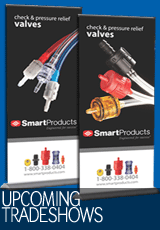|
November 2014 - Issue 162
e-news for Flow Control Solutions |
|

|
|
Shipping During the Holidays Please Note: The last date we will accept orders to be shipped in December will be Monday, December 15. For orders over 10,000 pieces, please call for confirmation that the order can be completed by that date. 1-800-338-0404. 

|
|
Check Valve Operation
 Understanding the intricacies of Check Valve Operation can save time and money when creating current or future applications. At Smart Products, we customize every component of our valves – from body materials, o-rings, spring pressure, and more. This flexibility ensures accurate flow control and/or pressure relief to fit a specific design criteria. Below is a brief summary of how our check valves work. To view the each stage in detail click here.  Stage 1: Shut Stage 1: ShutThe valve is closed, but not dormant - valve's components (plastic, o-rings, and springs) are in contact with each other. When the liquid/gas to be used in the valve is added, it is also idle at this stage, but in contact with all components. *To ensure optimal valve performance every time, it is important to communicate the following when ordering: shelf life of a valve, liquids/gasses used, and application environment.  Stage 2: Opening Stage 2: OpeningOur check valves don't switch on and off; they gradually open based on pressure. Notice the gradual increase of liquid/gas (highlighted in blue) and how it touches the o-ring, but isn't fully flowing yet. Choosing the right spring pressure and the right o-ring is critical to ensure valves open smoothly every time.  Stage 3: Open Pressure builds --> the o-ring lifts off the cartridge seat --> a significant amount of liquid/gas (highlighted in blue) flows through the valve. Note: We assign the valve's opening PSI during this stage. Also, if you’re looking for relief valves, this stage is a critical component to understand because an accurate open pressure ensures your device will function exactly to your device requirements.  Stage 4: Fully Open Stage 4: Fully OpenThe pressure moves fluid through the valve with such velocity that the poppet travels to its limit. At this point, the valve has achieved a FULLY OPEN state. If customers desire more flow here or want to maintain a particular level of pressure, click here to read the full description of how our valves work during this stage.  Stage 5: The Descent & Stage 6: Touch Down Stage 5: The Descent & Stage 6: Touch DownPressure decreases, and the spring begins to push the poppet back towards the shut or re-seal position. When the internal components (poppet, spring, & o-ring) continue to travel, they eventually make contact with the o-ring seat, also known as Stage 6: Touch Down. The valve will not seal well at this stage because there is no force pressing the o-ring back into the seat. Stage 7: Resealing & Stage 8: Rese  t tThe o-ring continues its journey back to the seat. Previously, the o-ring was only touching the seat, but now the spring force (via the poppet) has compressed the o-ring enough to hold it into place and create a seal against every gap. This stage is particularly noteworthy for customers with applications that cannot drop below a certain pressure because reseal pressure will always be lower than the open PSI. Once the valve reseals, it is in Stage 8: Reset. The valve has returned to its original position and is ready to go through all eight stages of operation again. Note: To ensure accurate and reliable flow control, all of our spring-loaded valves have been extensively tested to determine their open, regulated, and reseal pressures. __________________ Important: The more we know about your low pressure, low flow needs, the better equipped we will be in selecting the right components to create a precise and accurate valve exclusively for your application. For questions or to learn more, call (800) 338-0404 or email sales@smartproducts.com. To view a PDF of our entire product catalog, click here. |
|
|
Examining the Science of Rubber for Optimal O-ring Seals
|
|
|
 |







 O-rings are a crucial component in our valves because they keep the poppet in place, as well as move forward off of the poppet’s cartridge seat to allow regulated flow through the valve. At first glance, o-rings can be described as circular rings of rubber used as seals for our check valves. However, when viewed at a structural level, they are a lot more complex. Their chemical makeup can be altered in a variety of ways to meet application-specific needs. This SmartTalk touches on the scientific aspects for three of our o-ring material options: Buna-N and EPDM, both copolymers, as well as Viton®, a fluorocarbon.
O-rings are a crucial component in our valves because they keep the poppet in place, as well as move forward off of the poppet’s cartridge seat to allow regulated flow through the valve. At first glance, o-rings can be described as circular rings of rubber used as seals for our check valves. However, when viewed at a structural level, they are a lot more complex. Their chemical makeup can be altered in a variety of ways to meet application-specific needs. This SmartTalk touches on the scientific aspects for three of our o-ring material options: Buna-N and EPDM, both copolymers, as well as Viton®, a fluorocarbon. EPDM, another copolymer, is known by the chemical name ethylene-propylene diene rubber. Like Buna-N, its properties can be manipulated to change certain characteristics of the o-ring, such as the ethylene and diene contents.
EPDM, another copolymer, is known by the chemical name ethylene-propylene diene rubber. Like Buna-N, its properties can be manipulated to change certain characteristics of the o-ring, such as the ethylene and diene contents.